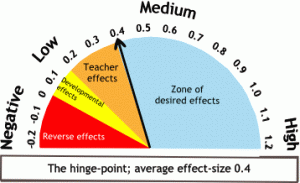This is post number nine in a ten part blog series (you may click here to start from the beginning).
This blog series serves to highlight the most significant findings from John Hattie’s 2012 work, Visible Learning for Teachers: Maximizing Impact on Learning and their applications to our classrooms. His work has given educators quantifiable insights that have no parallel in the field of education.
Need an introduction or a crash course on the effect sizes referenced below? An effect size of 0.40 is what Hattie refers to as a hinge-point regarding what is significantly effective or at “a level where the effects of innovation enhance achievement in such a way that we can notice real-world differences” (Hattie, 2009). Anything between a 0.00 and 0.39 is growth, but is not considered significant growth. Anything below a 0.00 is considered detrimental to student growth.

Number 2 – Piagetian Programs (effect size = 1.28)
For those of you that need a refresher from your educational psychology experiences, Piaget argued that children develop thinking through a succession of stages:
- Sensorimotor stage (birth to 2 years)
- Preoperational stage (2 to 7 years)
- Concrete operational stage (7 to 12 years)
- Formal operational stage (12 years to adulthood)
Hattie states the importance of “knowing the ways in which they [students] think, and how this thinking may be constrained by their stages of development may be most important to how teachers choose materials and task, how the concept of difficulty and challenge can be realized in different tasks, and the importance of developing successive and simultaneous thinking” (2009, p. 43).
Application to the Classroom
These findings scream for the need for us to emphasize personalized learning in our classrooms. Hattie shared that a major takeaway from the Piagetian effect size findings is that “we must know what students already know, know how they think, and then aim to then progress all students towards the success criteria of the lesson” (2012, p. 44).
Teachthought.com provides you a Beginner’s Guide to Personalized Learning which emphasizes the importance of starting with the individual learner and asking the question, “What does the student need to understand, and how best can that happen?” This approach recognizes and applies the idea that students learn in a variety of different ways. When we appreciate the Piagetian stages of student progress through personalized learning we can best meet the individual needs of all of our students.
A Random Mention
Number 93 out of 150 – Ability Grouping for Gifted Students (effect size 0.30)
First, it is important to note that Hattie is referring to gifted programs as having a different curricula. This is different than what he refers to as high-ability tracking, where students receive a faster pace of instruction and higher level tasks within the same curriculum as their peers. Hattie found that there were positive teacher effects, although not to the zone of desired effects, for gifted programs aimed at challenging students at the appropriate level to promote their engagement and learning.
A Peek at the Bottom 10
Number 142 out of 150 – School College Halls of Residence (effect size 0.05)
Hard to find a connection to K-12 public education here. The research data show living in dorms, fraternities and sororities, homes, apartments, etc. have no impact on student learning.
For more from this blog series view the following posts:
#8 – Comprehensive Interventions for Learning Disabled Students
#5 – Providing Formative Evaluation of Programs
Hattie, J., Visible Learning: A Synthesis of Over 800 Meta-Analyses Relating to Achievement (2009)
Hattie, J. Visible Learning for Teachers: Maximizing Impact on Learning (2012)
http://www.teachthought.com/category/learning/personalized-learning/
Effect size image retrieved from: http://www.learningandteaching.info/teaching/what_works.htm
Personalized learning image retrieved from: http://www.teachthought.com/category/learning/personalized-learning/





Leave a Reply